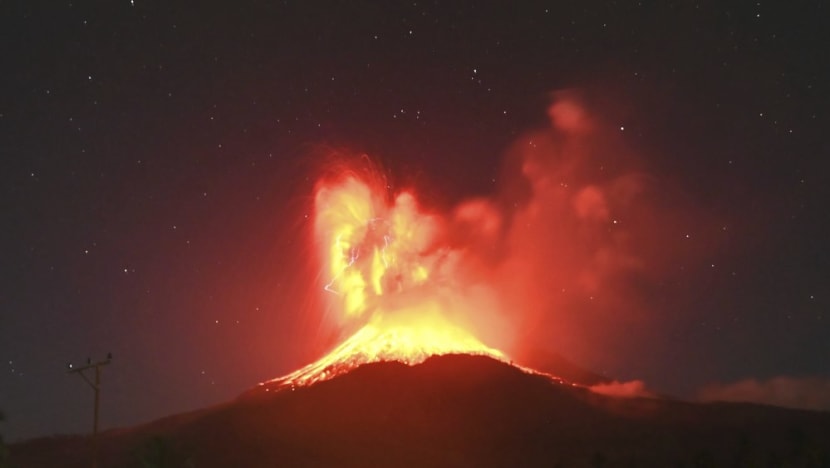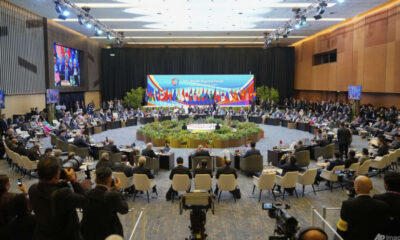Top Stories
Mount Lewotobi Laki-laki Erupts Again, Sends Ash 18km High

Mount Lewotobi Laki-laki, one of Indonesia’s most active volcanoes, erupted twice within a span of fewer than five hours, with the latest eruption occurring on August 2, 2023. This powerful explosion propelled a column of volcanic ash and materials up to an astonishing height of 18 kilometres, resulting in thick debris blanketing nearby villages. Fortunately, no casualties have been reported so far.
The previous eruption took place on the evening of August 1, sending ash clouds soaring to approximately 10 kilometres. This eruption was particularly dramatic, illuminating the night sky with glowing lava and bolts of lightning. According to Indonesia’s Geology Agency, the eruption also resulted in an avalanche of searing gas clouds, which traveled up to 5 kilometres down the slopes of the volcano.
Drone observations have revealed significant magma movement beneath the volcano, triggering tremors that were detected by seismic monitors. Volcanic materials, including hot gravel the size of a thumb, were ejected up to 8 kilometres from the crater, covering towns and villages with a thick layer of volcanic residue. The agency has advised local residents to remain vigilant, especially regarding heavy rainfall, which could potentially trigger lava flows in rivers originating from the volcano.
Historical Context and Ongoing Concerns
Saturday’s eruption marks one of the largest volcanic events in Indonesia since 2010, when Mount Merapi erupted on the densely populated island of Java, resulting in over 350 fatalities and forcing hundreds of thousands to evacuate. This recent eruption also follows a major event on July 7, which disrupted air travel and led to the cancellation of numerous flights at Bali’s Ngurah Rai Airport. The volcanic activity covered roads and rice fields with thick, gray mud and rocks, compounding the challenges faced by local communities.
Mount Lewotobi Laki-laki, standing at 1,584 metres on the remote island of Flores, has been on the highest alert level since its eruption on June 18. In light of the increasing frequency of eruptions, the Indonesian government has expanded the exclusion zone around the volcano to a 7-kilometre radius, prioritizing the safety of residents in the area. The government has previously relocated thousands of residents following a series of eruptions in November that resulted in nine fatalities and the destruction of many homes.
Indonesia, home to over 280 million people, is situated along the “Ring of Fire,” a region known for its frequent seismic and volcanic activity. The nation is home to 120 active volcanoes, making it one of the most volcanically active regions in the world. As the situation continues to evolve, authorities are closely monitoring Mount Lewotobi Laki-laki and its potential impacts on local communities and infrastructure.
-

 Business5 months ago
Business5 months agoKenvue Dismisses CEO Thibaut Mongon as Strategic Review Advances
-

 Lifestyle4 months ago
Lifestyle4 months agoHumanism Camp Engages 250 Youths in Summer Fest 2025
-

 Sports4 months ago
Sports4 months agoDe Minaur Triumphs at Washington Open After Thrilling Comeback
-

 Sports5 months ago
Sports5 months agoTupou and Daugunu Join First Nations Squad for Lions Clash
-

 Top Stories5 months ago
Top Stories5 months agoColombian Senator Miguel Uribe Shows Signs of Recovery After Attack
-

 World5 months ago
World5 months agoASEAN Gears Up for Historic Joint Meeting of Foreign and Economic Ministers
-

 Health4 months ago
Health4 months agoNew Study Challenges Assumptions About Aging and Inflammation
-

 Business5 months ago
Business5 months agoOil Prices Surge Following New EU Sanctions on Russia
-

 Entertainment4 months ago
Entertainment4 months agoDetaşe-Sabah Violin Ensemble Captivates at Gabala Music Festival
-

 Entertainment4 months ago
Entertainment4 months agoBaku Metro Extends Hours for Justin Timberlake Concert
-

 Top Stories5 months ago
Top Stories5 months agoRethinking Singapore’s F&B Regulations Amid Business Closures
-

 Business5 months ago
Business5 months agoU.S. House Approves Stablecoin Bill, Sends to Trump for Signature









